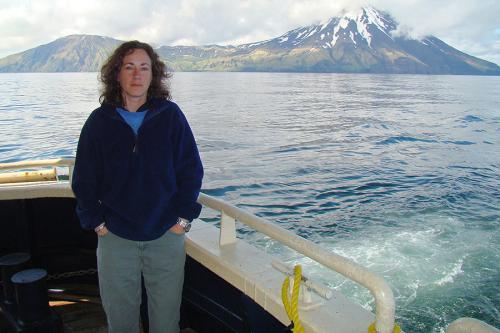Pat Donovan / University at Buffalo
Source -http://phys.org/news/2014-04-ancient-aleuts-large-scale-environmental-events.html

Caroline Funk at work on Kiska Island.
Archaeologists contribute to the global debate about long-term human intersections with coastal and island environments, often through cooperative research with anthropologists, geologists and bioscientists, and frequently in places like Kiska Island in the Rat Island Archipelago, more than a thousand miles off the coast of Alaska.
Such is the case with archaeologist Caroline L. Funk, PhD, research assistant professor in the University at Buffalo Department of Anthropology, and a multidisciplinary team including representatives of six federal agencies and academic colleagues from across the United States.
They have received a startup grant in the amount of $242,733 from the National Science Foundation for a one-year project involving field research and laboratory analyses of the environs of Kiska Island, one of the largest of the volcanic Rat Islands in Alaska's western Aleutians.
Funk says the team's work will aid in decision-making about restoration ecology and land management while advancing socionatural and identity theories about the impacts of small-scale societies on their landscapes.
"We hope to contribute valuable data regarding human and large-scale environmental event impacts to studies of the North," she says.
The project, which will run through February 2015, will research human impacts on resources and environmental/ecological histories by studying the prehistoric Aleut archaeological record and the environmental history of Kiska Island, notably the history of human use of the island.

Caroline Funk on the research ship Tiglax approaching Kiska Island. The Kiska volcano is on the left.
Funk's co-principal investigators are Nicole Misarti, PhD, research assistant professor, Water and Environmental Research Center, University of Alaska, Fairbanks, and Brian Hoffman, PhD, associate professor and chair, Department of Anthropology, Hamline University, St. Paul, Minn.
"New environmental and human histories of Kiska Island and Rat Islands Aleuts developed from our synergy of anthropology/archaeology, bioscience and geoscience," Funk says, "and when linked to regional and global data sets, will expand our understanding of the form and function of island ecosystems and human relationships with them."
Funk says this initial research will consider several issues:
-
How the prehistoric Rat Islands Aleuts lived within and conceived of their landscape.
-
How the environment shaped Rat Islands Aleut culture.
-
What physical and climatic conditions and events were endured by the Rat Islands Aleuts and how these affected their environment and indigenous plant and animal species.
-
What role humans played in shaping the form and characteristics of landscapes, seascapes and non-human species of the islands.
Field work will include an archaeological survey aimed at locating new archaeological sites and testing known and newly discovered sites. Pollen coring will provide pollen and plant macrofossil data, as well as high-resolution tephra sequences.
"These can tell us about large-scale volcanic events that may have impacted humans and their resources," Funk says. Kiska features a more-than-4,000-foot active volcano of the same name.
In addition, Funk says an island intertidal survey will set baseline data for modeling the regional food web. Laboratory analyses will be performed on all materials collected during fieldwork, creating the multidisciplinary, comparative data sets necessary to test the study's hypotheses about recursive human/environment impacts.
"Sea mammal population characteristics will be measured by isotope and trace element analyses performed on archaeological specimens," she says, "which will offer up information about prehistoric subsistence harvests and marine ecosystem dynamics when combined with the new food web models."
This research project reflects many of Funk's research interests: human decision-making in the context of environmental influence and impact; cognitive archaeology and landscape approaches in prehistoric, historic contact and historic eras; hunter-gatherers in such coastal landscapes as the Aleutian Islands, Alaska's Yukon-Kuskokwim Delta and central Portugal; oral history; ethnohistory; settlement-pattern analysis; and faunal analysis.